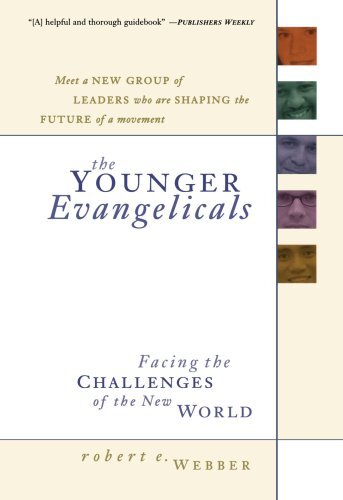Robert E. Webber, The Younger Evangelicals: Facing the Challenges of the New World (Baker Books, 2002).
Referenced in:
LifeandLeadership.com Summary
See the essay for definitions. Webber is a comparative ecclesiology, drawing a distinction between three different eras/types of evangelicals.
Summary: Webber describes three different eras/types of evangelicals. The first are Traditional Evangelicals of the post-WWII era, 1950s-1970s, often called “The Traditionals.” They were the conservative, Bible-believing churches of the stable churched-culture period that enjoyed widespread Christian influence and relative sameness between the three main institutions of society: family, school, and church. The leading cultural figure of “The Traditionals” is Billy Graham.
Webber’s second typology is the Pragmatic Evangelicals who emerged in the 1960s, but came of age in the 1970s-1990s. They were the seeker-targeted, church-growth-oriented churches, often called “The Attractionals” because they sought to “attract” the unchurched by offering appealing services. Following a principle of “accommodation without compromise” (Rick Warren), these churches popularized contemporary worship, ministering to felt-needs, and building huge facilities with gymnasiums, all with the intent of reaching disenfranchised baby boomers and older busters. The leading cultural figures of “The Attractionals” are Bill Hybels of Willow Creek Community Church and Rick Warren of Saddleback Valley Community Church (Purpose Driven Church).
Webber’s third typology is the “Younger Evangelicals,” the “twenty-somethings” who come of age in the post-9/11 postmodern era, after 2000. Younger Evangelicals are often called “The Missionals,” in distinction from the previous group of church-growth enthusiasts, “The Attractionals.” “Missional” is an adaptation of the Latin term Missio Dei, which may be translated “Mission of God.” It affirms the belief that God has a mission for the world and that he is always sovereignly at work toward that mission, sometimes in ways that are perceptive to us and often in ways that are not. God’s desire for the world goes beyond simply evangelism, but also incorporates concerns of social compassion and justice toward the creation of whole communities of people (indeed the whole creation) who experience the benefits of God’s reign.
Webber is obviously a missional proponent. In fact, just before his death in 2007, he was a principal author of “The Call to an Ancient Evangelical Faith” (or AEF Call). It is a succinct statement of what many younger evangelicals long for.
Webber’s bias notwithstanding, his book is still arguably the best resource for understanding religious 20-30-somethings. He describes twenty-four specific characteristics of Younger Evangelicals, and presents over a dozen detailed charts comparing them with the previous generations on issue like communication, theology, history, apologetics, ecclesiology, church ministry, role of pastors, youth ministry, education, worship, spiritual formation, art, evangelism, and activism. In the process, Webber provides some of the best introductory descriptions of terms like postmodern, emergent, missional, etc.
***For additional information on this resource, including reviews, click the bookstore links. Check the reference at page top or the links below for resource guides on related topics.***
See Related Resources
See Other Resources on Generational Issues:
Missional Perspectives:
- Missional Perspectives 01, Introduction
- Missional Church Resources, Introduction and Index
- Missional Philosophy
- Ecclesiology
See Resources on Over 100 Areas of Ministry Leadership:


